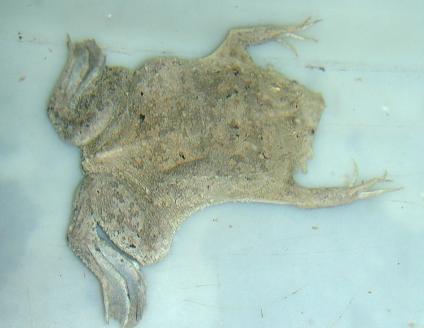


|
Pipidae :
There are 5 genera and 30 species in this family. These frogs lack a tongue, have dorsoventrally flattened bodies, fully webbed hind feet, small dorsally placed eyes, and retain a lateral line system. Tadpoles resemble small catfish due to their paired anterior barbells (absent in Hymenochirus whose tadpoles are carnivorous). Males in this family lack vocal cords but are able to communicate underwater via “clicking” sounds generated through a modified laryngeal apparatus. The Surinam Toad, Pipa pipa, amplexes (mates) in a circular motion underwater allowing for the eggs to be deposited on the females back, which are later enveloped by skin from which later froglets emerge fully formed. Members of this family can be found in almost every kind of water body in Africa and South America. As a result of their high ability to adapt in a variety of environments, members of the genus Xenopus have become a model lab organism. Characters for this group are: 1) epipubis present; 2) unpaired epipubic muscle; 3) quadratojugal absent; 4) free ribs in larvae; 5) sacrococcygeal articulation fused; 6) short, stocky sacrum; 7) elongate septomaxillae; 8) lateral line system present in adults; 9) tongues absent; 10) non-pedicellate teeth in Xenopus and some Pipa (other Pipa are edentate – have very few or lack teeth completely).
Genus :
Hymenochirus (4 species)
Pipa (7 species)
Pseudhymenochirus (1 species)
Silurana (2 species)
Xenopus (17 species) |
